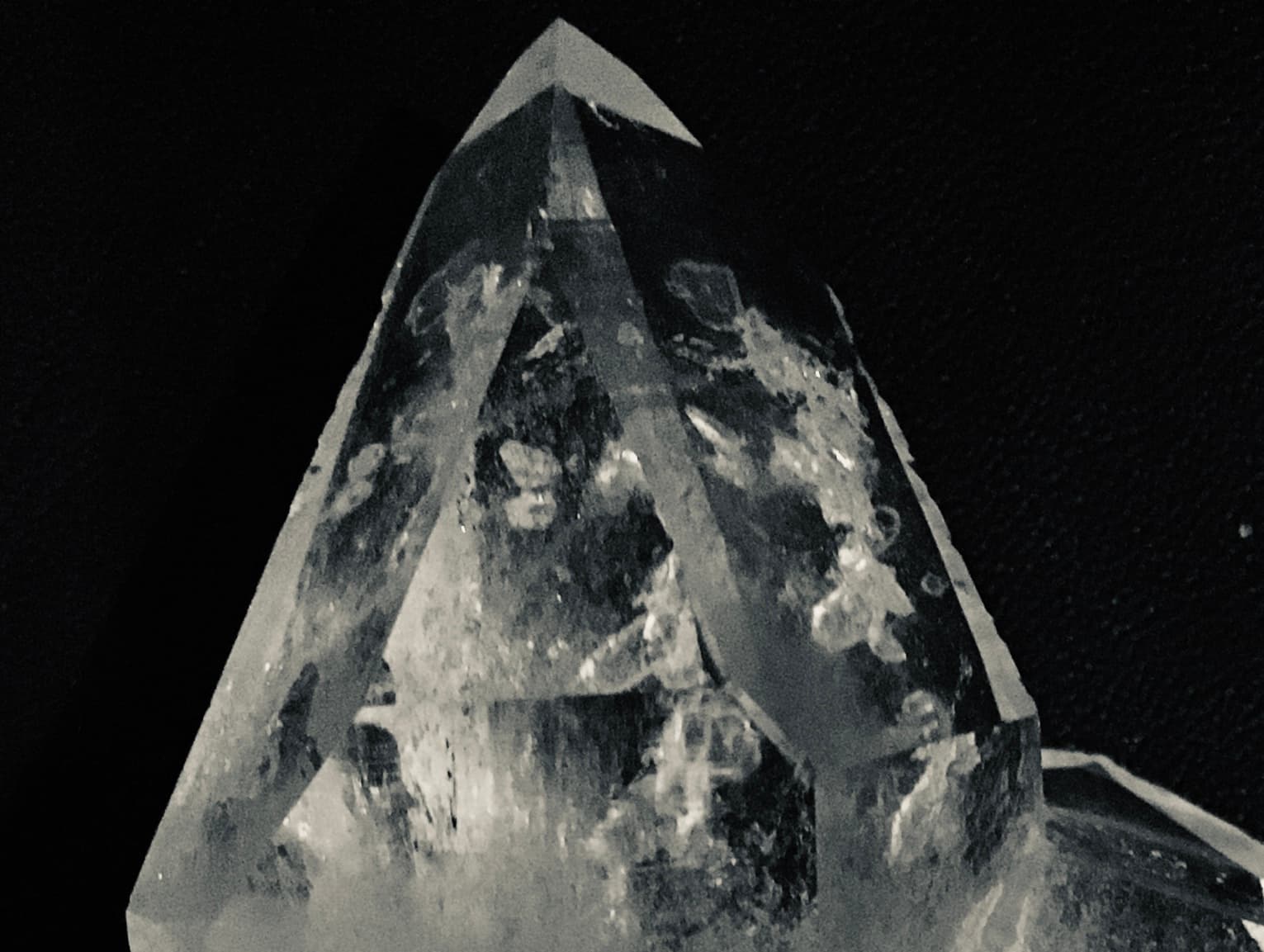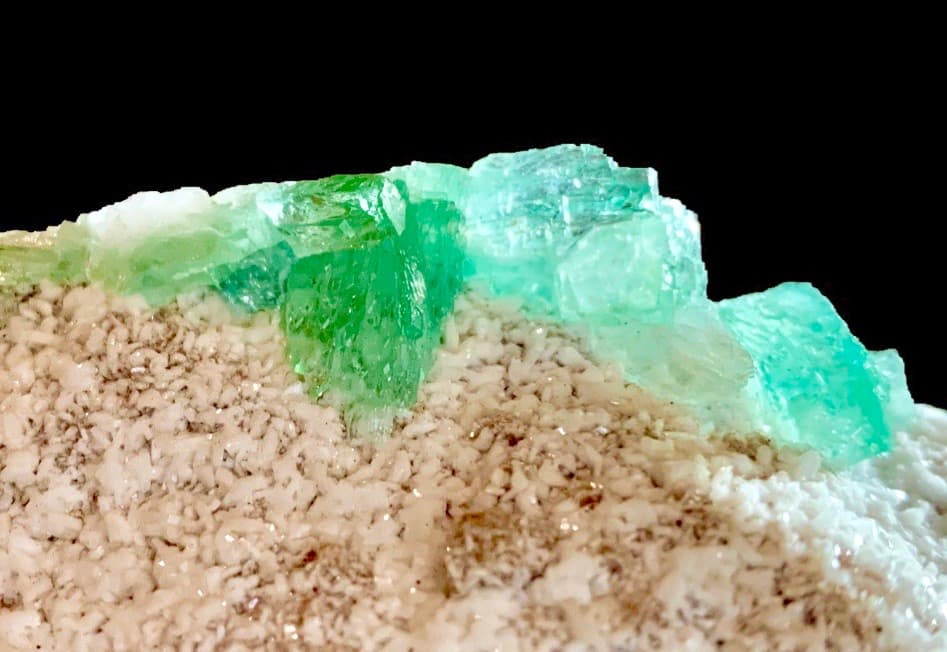The ‘silicate’ group refers to minerals containing molecules of silicon and oxygen. All silicates contain tetrahedron-shaped crystal structures. The tetrahedra are comprised of one silicon atom surrounded by several oxygen atoms covalently bound on their vertices. The tetrahedra form a larger network to create a chemical and crystal structure.
Silicates are divided into six (or seven) major classes based on the chemical structure of the silicon and oxygen anion. The chemical structure of silicates is formed by tetrahedra which bind to create a larger network.
Groups
Tectosilicates
 Quartz from Mt. Ida, Arkansas, U.S.
Quartz from Mt. Ida, Arkansas, U.S.
The largest group of silicates, tectosilicates, compose approximately 75% of Earth’s crust and include the major rock-forming minerals feldspar and quartz. The crystal structure is composed of a three-dimensional network of tetrahedra with a SiO2 formula. Minerals in the group often crystallize in magma veins or hydrothermal vents by metamorphic processes. All tectosilicates, except quartz, contain aluminum; hence their designation as aluminosilicate.
Examples
-
Quartz:
-
Citrine, Amethyst, Smoky Quartz
-
Chalcedony
-
Agate
-
-
Feldspars
-
Alkaline (Pottasium) Feldspars:
-
Microcline
-
Amazonite
-
Orthoclase
-
-
Plagioclase Feldspars:
- Albite
-
Zeolites
-
Heulandite
-
Stilbite
-
Phyllosilicates
 Chrysocolla from Katanga, D.R. of Congo
Chrysocolla from Katanga, D.R. of Congo
Phyllosilicates are hydrated; they contain or originate from water. The name Phylosillicatesoriginated from the Greek word Phyllos or leaf, because of its sheets or nets of tetrahedral structures. The sheets are parallel and contain Si2O5. Phyllosilicates vary widely in appearance, ranging from generally dull clay minerals to attractive Cavansite, which forms blue ‘flower-like’ masses. Minerals in this group often form via a water-related process.
Examples
-
Mica
-
Lepidolite
-
Muscovite
-
Biotite
-
-
Clay minerals:
-
Talc
-
Kaolinite
-
Pyrophyllite
-
-
Olivine
-
Non-structure-defined minerals:
-
Chrysocolla
-
Gem Silica
-
-
Apophyllite
-
Chlorite
Inosilicates
 Arfvedsonite from Zomba, Malawi
Arfvedsonite from Zomba, Malawi
Inosilicates (a.k.a Chain silicates) have connected chains of silicon tetrahedra, either SiO3 or Si4O11 depending on whether the mineral is a single or double chain, respectively. Double-chain silicates have a more complex net of tetrahedral single-chain silicates. Inosilicates crystallize primarily in magma veins, hydrothermal vents, and rocks containing high amounts of silica.
Examples
Single Chain:
-
Diopside
-
Pyroxene
-
Rhodonite
Double Chain:
-
Arfvedsonite
-
Tremolite
-
Actinolite
-
Jadeite
-
Nephrite
-
Sorosilicates
 Vesuvianite from Jeffery Mine, Asbestos, Quebec, Canada
Vesuvianite from Jeffery Mine, Asbestos, Quebec, Canada
 Tanzanite from Merelani Hills, Manyara Region, Tanzania
Tanzanite from Merelani Hills, Manyara Region, Tanzania
Sorosilicates have complex double tetrahedral structures similar to cyclosilicates, worthy of the name originating from the Greek word soros, meaning heap or pile. The double tetrahedral structures are connected by a shared oxygen vertex or atom. Most sorosilicates contain metals. The tetrahedra contains (Si2O7)6-.
Examples
-
Hemimorphite
-
Epidote
-
Zoistite, Clinozoistite
-
Allanite, Dollaseite
-
-
Vesuvianite
Nesosilicates/Orthosilicates
 Garnet (Orange) from Fujian, China
Garnet (Orange) from Fujian, China
Nesosilicates, or Orthosilicates, contain isolated tetrahedra only connected by interstitial cations. The orthosilicate ion contains [SiO4]4−. They often form in metamorphic rocks with some occurrence in igneous rocks.
Examples:
-
Zircon
-
Al2SiO5
-
Topaz
-
Kyanite
-
Staurolite
-
-
Olivine
-
Garnet
Cyclosilicates
 Double Chain: Aquamarine, Muscovite, Albite, from Afghanistan
Double Chain: Aquamarine, Muscovite, Albite, from Afghanistan
 Tourmaline, Quartz, Muscovite from Urubu Mine, Itinga, Minas Gerias, Brazil
Tourmaline, Quartz, Muscovite from Urubu Mine, Itinga, Minas Gerias, Brazil
Cyclosilicates, or ring silicates, have three or more tetrahedra linked in a ring-like structure. Each ‘ring’ has either three or six tetrahedra and is grouped into ‘three-member’ and ‘six-member’ cyclosilicates. The chemical formula for the two groups is (S3O9)6− and (S6O18)12−, respectively.
Examples:
3 Member:
- Benitoite
6 Member:
-
Beryl:
-
Aquamarine
-
Emerald
-
Morganite
-
Heliodor
-
-
Tourmaline:
-
Elbaite
-
Schorl
-
Indicolite
-
Dravite
-
Sugilite
-
Dioptase
-
Papagoite
Silicate minerals vary considerably in visual appearance and chemical attributes. The only similarity shared by each subclass is the tetrahedral crystal structures and the presence of oxygen and silicon. The six groups combined compose approximately 90% of Earth's crust, and are an important foundation of Earth's crust.
Glossary
Covalently*: chemical bonds formed by the sharing of electrons by atoms* Cations: Ions with positive charges.
References
"Silicate minerals", Wikipedia, 1 August 2019 https://en.wikipedia.org/wiki/Silicate_minerals ↗ "Silicates", Wikipedia, 1 August 2019 https://en.wikipedia.org/wiki/Silicate ↗
